How to Conduct an Effective SEO Audit [Worksheet Included]
Understanding how SEO can drive business results
Conducting an SEO Audit takes a lot of time and effort and you can get lost pretty quickly.
In this article, we’ll go over how SEO can help you drive Real Business Results so you can focus on what matters most.
Related: How to conduct a YouTube Audit.
In this audit checklist
- Entenda seu público e crie conteúdo eficaz
- Como descobrir quais tipos de conteúdo estão gerando os melhores resultados de negócios
- Potencial de crescimento de SEO
- Concentre-se nos momentos AHA e na jornada do cliente
- Conduzindo e expandindo sua pesquisa de palavras-chave
- On-Page SEO
- Repita a lista de verificação de auditoria de SEO
- Perguntas frequentes
Understand your audience and create effective content
In marketing, we often talk about vanity metrics. Especially when it comes to setting up your Social Media Marketing Strategy, but understanding which metrics matter most to you in terms of SEO and Content and which metrics are hindering you in making the right decisions is crucial.
I often hear from CMOs and VPs of Marketing:
“We don’t just want more traffic,we want the right kind of traffic”
I agree 100%. That goes without saying for me. But the reason they bring it up is because way too often, SEOs focus on just getting the traffic number up and in their eyes, they did a good job.
I would say that is the wrong approach. As an SEO (in-house or freelance) you always need to understand:
- What has worked well in de past in terms of getting leads, MQLs, Sales in?
- What does that tell us? What types of content are really driving business results and why?
- Which areas did we not explore yet and do we want to run experiments on?
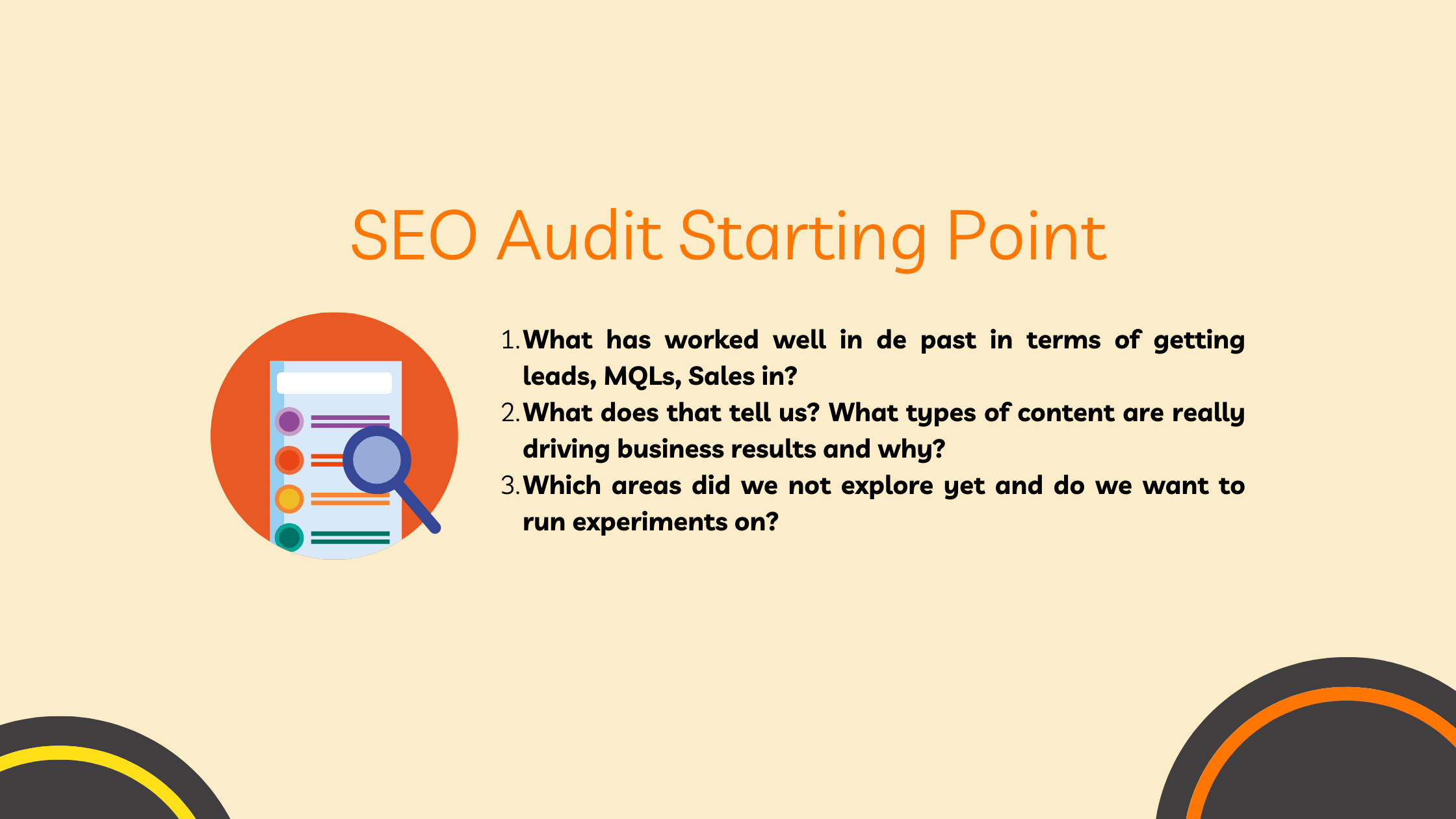
When you understand these three elements, you can dive into:
- Prioritizing the types of content that are most valuable to us;
- Doing on-page optimization for these content types;
- Optimizing internal linking;
- (optionally) doing external linking.
Additional resource: On-Page SEO Optimization Checklist + Fre Worksheet
If you would stop reading this SEO Audit article and just focus on the points above, you would probably already be successful with driving more and better business results with the help of SEO and Content.
How to find out which Content Types are driving the best business results
Alright, let’s dive a little bit deeper. How do you find out which pages, content types, keywords, etc. are driving the best business results so we can learn, optimize and scale what works?
First of all, it might be different if you’re doing the SEO Audit for a B2B website or B2C. With B2B websites, it might be a bit more difficult to get the right data, especially because ‘time to purchase’ is often longer than for instance an E-Commerce website.
Still, the way I approach it is by looking at:
- Are there individual pages that indicate success?
- Are there clusters of pages that indicate success?
- Group of product pages;
- Group of pages, and articles that focus on the same keywords ;
- Group of page types (video pages, example pages, etc.);
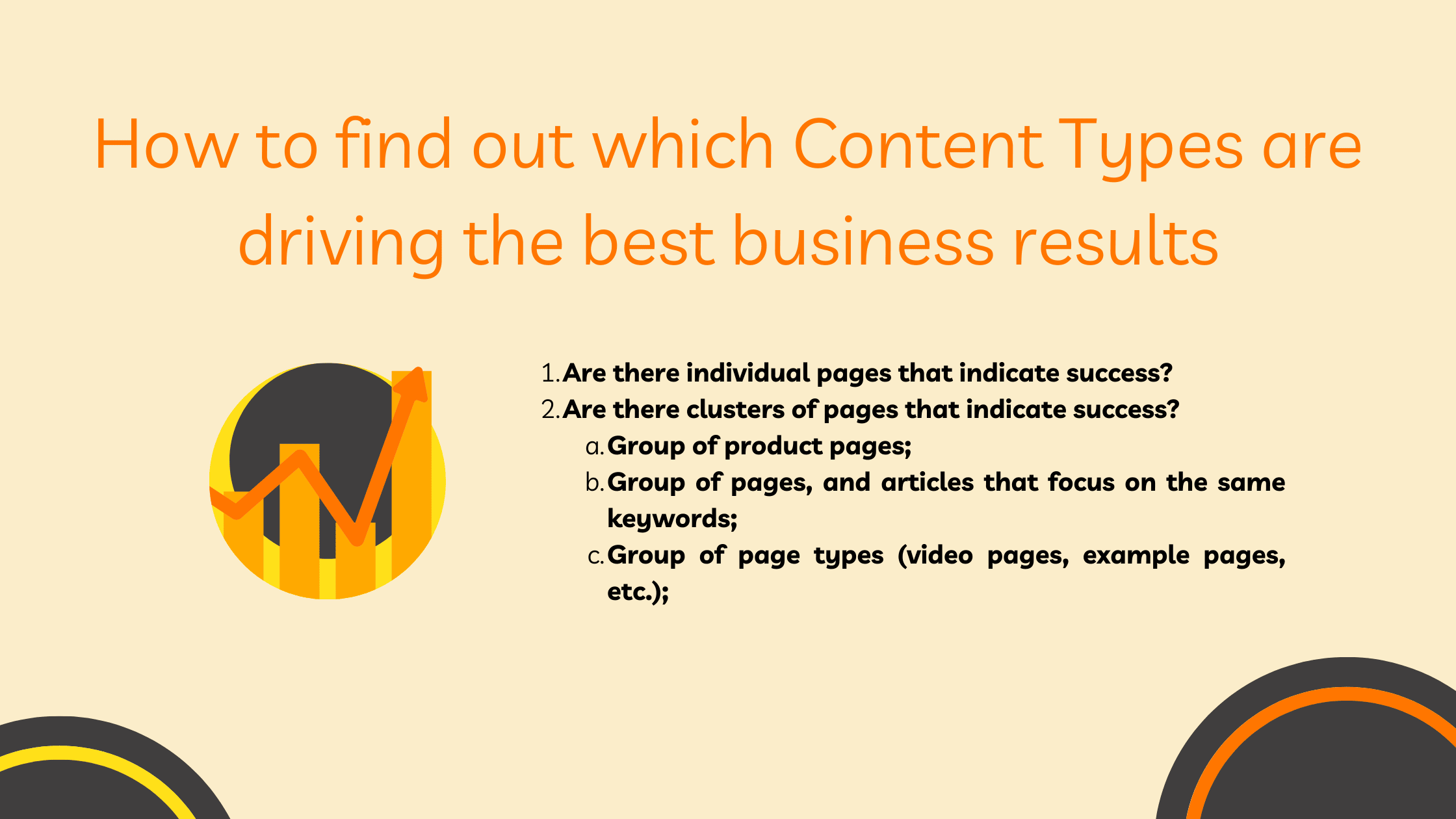
Example:
At StoryLab.ai we write about various topics and have various types of pages. When doing an SEO Audit I would look at:
- Which individual pages are bringing in the most users and sales?
- How many visitors for all product pages combined do we need for 1 user and 1 sale?
- How many visitors for all example pages combined do we need for 1 user and 1 sale?
- How many visitors for all Social Media Marketing pages combined do we need for 1 user and 1 sale?
- How many visitors for all SEO pages combined do we need for 1 user and 1 sale?
- How many visitors for all Video Marketing pages combined do we need for 1 user and 1 sale?
What we see is that product pages by far bring in the best value traffic. For every 5 visitors, we get 1 new user.
We also see that Social Media related content bring in more users per visitor compared to SEO and Video Marketing.
So that is great data to make some decisions.
It does not mean that by having this data, we don’t write SEO articles anymore (otherwise we would not have written this SEO Audit article). But it does mean that the bulk of our link-building efforts goes towards our product pages and Social Media Related pages.
What’s missing in this analysis to help you make the right decisions?
- Value of data – Is this analysis based on just a handful of visitors? If so, you can’t really say anything yet. You need more traffic.
- What data is missing? – Which areas that make sense did we not cover yet and want to create content for to see how that performs?
- In our case, either dive deeper into the Social Media content (Instagram, Linkedin, Twitter, etc.), or look at new related topics like, copywriting, martech, email marketing, etc.
When content gaps become clear but internal resources are limited, partnering with experienced SaaS content marketing services can help fill those gaps with strategically crafted content that drives both traffic and conversions.
SEO Growth Potential
Now that we know what has been successful, let’s look at the growth potential. Here’s where Keyword Research and Competitor Research come into play.
Related: The Importance of Keyword Research + Free Template
It’s great that we found out that our product pages are performing really well, but how much growth potential do we still have? We’ve known that for quite a while and already focused our external and internal linking efforts on those pages, we keep refreshing the pages and doing On-Page Optimizations and ranking really well. How much more can we grow and how much effort do we want to invest in the next best thing (Social Media Marketing related articles) to sustainably grow and how much do we want to focus on new areas to explore?
Here’s what that could look like:
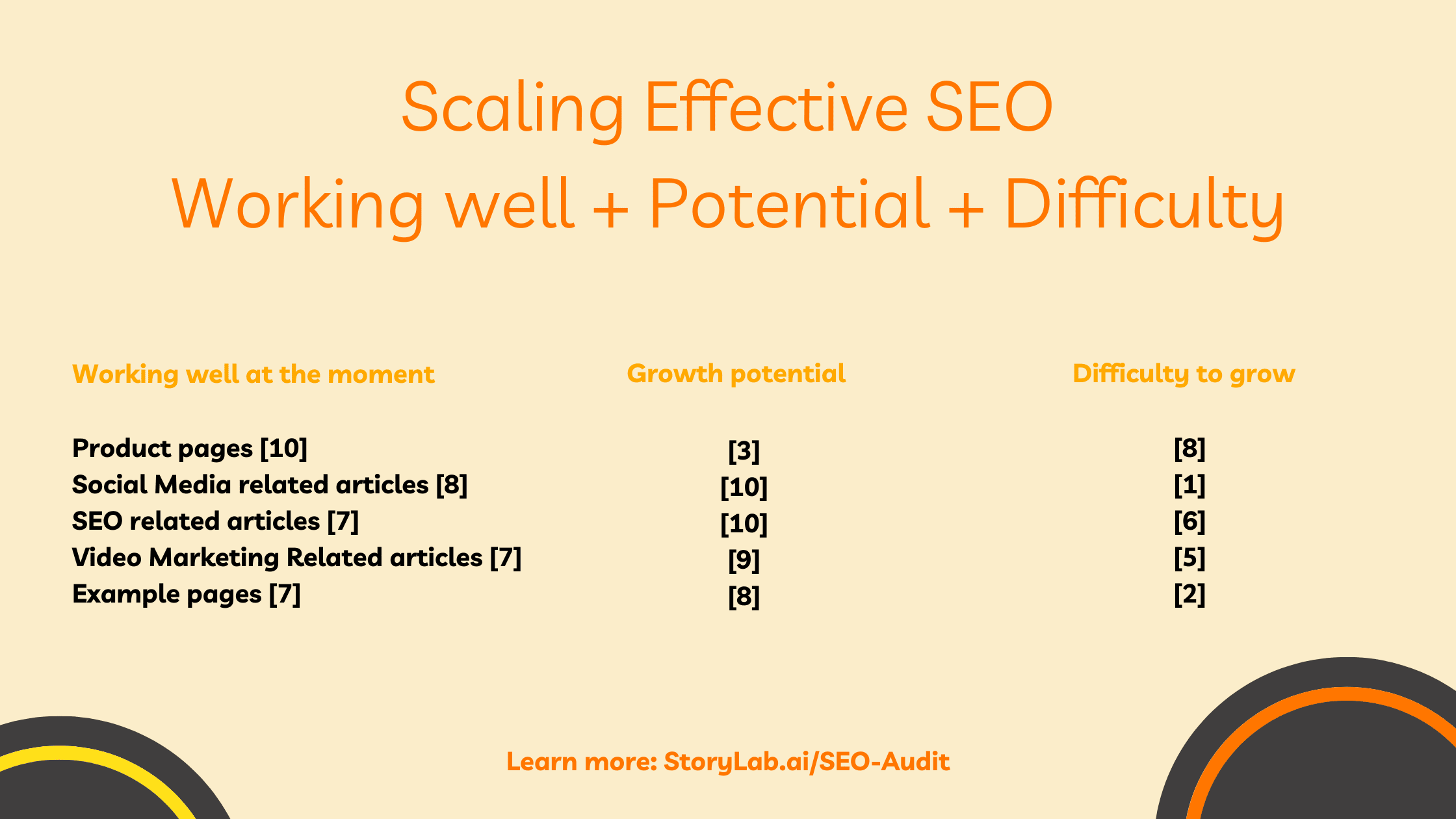
What you see in the image above is that:
- Our product pages are performing well, growth potential is pretty low, and the difficulty to grow even more (more traffic) is really high. We’ve done a great job at getting to where we are but really need to focus on what’s next to grow. We do need to invest time and effort to keep our positions. You’re never ‘done’ with SEO. When you stop investing, you’ll probably drop in rankings and traffic.
- Social Media Related content is performing well for us, the growth potential is high and the difficulty is ok-ish. We’re already ranking well for quite some Social Media Marketing related keywords, thus giving us the confidence that Google sees us as an authority on the topic, thus continuing to create Social Media related content should help us grow.
- SEO is a different story because we have not created that many pieces of content on that topic and it will probably take us more effort to rank well compared to Social Media related content.
So thanks to doing this SEO Audit, we know what we want to prioritize. Again, this does not mean neglecting the other topics and areas.
When diving deeper into the SEO Audit, we will start with the Social Media Marketing topics and work our way down from there.
When doing content distribution, the same applies.
Related resource: Setting up your Content Distribution Strategy [Free Sheet Included]
Focus on AHA-Moments and the Customer Journey
Before focusing on getting more traffic with the help of SEO, we look at how we can optimize existing content that already get’s a nice amount of traffic.
We agree with Tim Soulo, CMO at Ahrefs that we should build a lot of AHA moments with our content. Whenever Ahrefs talks about doing Keyword Research for instance, they don’t just give advice, they also show how you can do it with their tool.
Whenever we talk about the importance of creating social media posts consistently, we talk about how our AI-Powered Social Media Caption Generator can help. Here’s what that looks like:
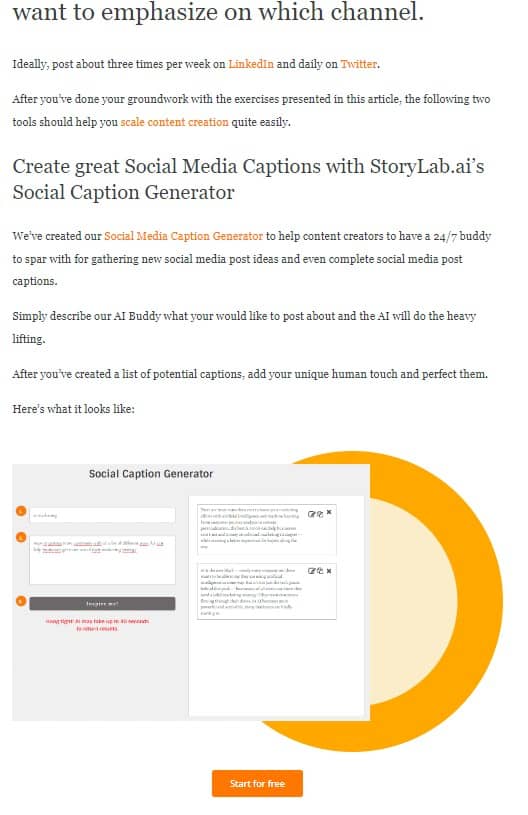
Some marketers call this ‘shameless plugging’. We disagree. If you believe in your product and know that many people have never heard about how it can make their lives easier, why would you not showcase how, in this specific situation, your product can help? It’s up to the reader to decide if they want to try your product out. The article should still be very helpful even if they don’t want to try your product, but it’s an extra resource that they can use to achieve their goals.
You don’t need to showcase your product in all pieces of content. But when it makes sense, well…
Conducting and expanding your Keyword Research
You should have already started with your Keyword Research when determining the growth potential of your topics and the difficulty. It’s now time to dive deeper. Because of the work we’ve done so far, we know that we should start by exploring the Social Media Marketing realm.
We would dive into Semrush and Google Search Console to create a list with the following datasets:
- Keyword;
- Global volume;
- Volume main geographic;
- Difficulty;
- Ranking position at the moment (if applicable);
- Which page(s) is (are) ranking for that keyword at the moment (if applicable);
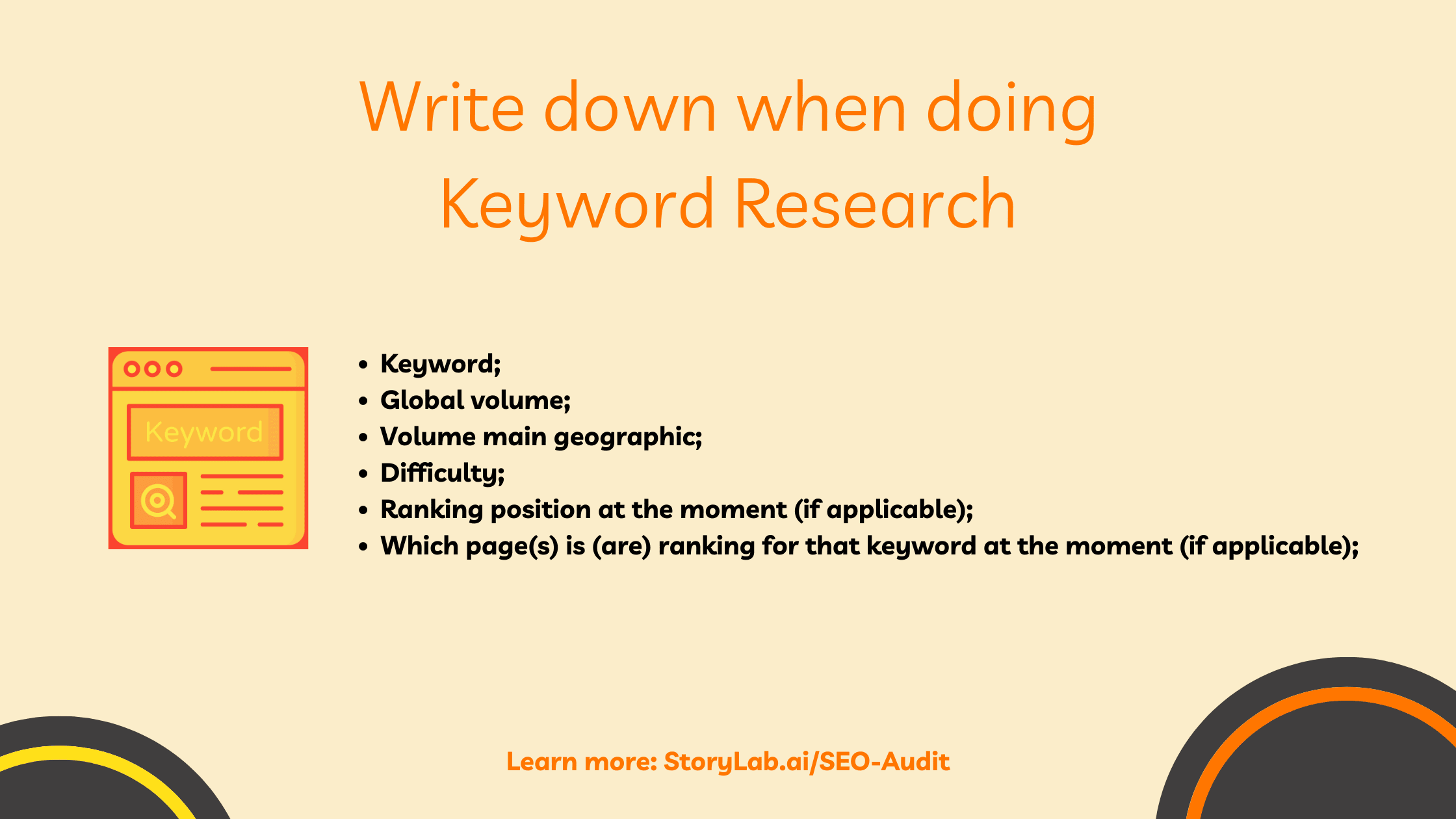
After having the data you need, you can decide:
- Which existing pages to optimize;
- Which new pages you need to create.
On-Page SEO
For optimizing your existing content, you might want to check out our On-Page SEO article and Checklist. Again, start with your most important pages first, and work your way down the list.
Also, use the On-Page SEO checklist when creating new content so you have your content optimized from the get-go!
Repeat the SEO Audit Checklist
You don’t do an SEO Audit once. Much will change over time and you want to understand exactly what is going on at all time. We keep track of our SEO KPIs each and every month. Whenever we see an increase or decline in new users and sales acquired, we know exactly why that is. An increase or decrease in traffic for our SEO articles doesn’t mean a big impact on our bottom line (yet). But even this can change over time.
Make sure you keep track of your KPIs, continually research new opportunities, and understand what is going on.
FAQ
What is an SEO audit?
An SEO audit is a comprehensive analysis of a website to assess its performance in search engine rankings, identifying areas for improvement in accordance with SEO best practices.
Why is an SEO audit important for websites?
An SEO audit is important because it helps identify strengths and weaknesses in a website’s SEO strategy, allowing for adjustments to improve search engine rankings and online visibility.
What are the key components analyzed in an SEO audit?
Key components include website structure, content quality, keyword optimization, backlinks, mobile-friendliness, page speed, and user experience.
How often should a website undergo an SEO audit?
Ideally, a website should undergo an SEO audit at least twice a year, or more frequently if significant changes are made to the website or to search engine algorithms.
Can an SEO audit help in identifying technical issues on a website?
Yes, an SEO audit can identify technical issues like broken links, crawl errors, and loading speed problems that may negatively impact search engine rankings.
What role does keyword analysis play in an SEO audit?
Keyword analysis in an SEO audit assesses the effectiveness of the keywords used in the site’s content, ensuring they align with targeted search queries and audience intent.
How does an SEO audit address content quality and relevance?
The audit reviews content for quality, relevance, and optimization, checking if it’s informative, well-structured, and includes appropriate keywords and meta tags.
Can an SEO audit improve a website’s mobile performance?
Yes, it includes analyzing the website’s mobile responsiveness and loading speed on mobile devices, crucial factors in modern SEO.
What is the significance of backlink analysis in an SEO audit?
Backlink analysis assesses the quality and relevance of external sites linking to the website, as high-quality backlinks can significantly boost SEO performance.
How can businesses use the findings of an SEO audit?
Businesses can use SEO audit findings to create a prioritized action plan for optimizing their website, addressing issues that will have the most significant impact on their search engine rankings and user experience.
What tools are commonly used for conducting an SEO audit?
Common tools for SEO audits include Google Analytics, Google Search Console, SEMrush, Ahrefs, Moz, and Screaming Frog, which provide insights into various aspects of website performance and SEO.
How does an SEO audit help with local SEO performance?
An SEO audit can help improve local SEO by analyzing local listings, NAP (Name, Address, Phone Number) consistency, local keywords, and content relevant to the local audience.
What impact does user experience (UX) have on an SEO audit?
UX plays a critical role in SEO; an audit assesses website navigation, design, content layout, and overall usability, as these factors influence search rankings and user engagement.
Can an SEO audit identify issues with website security?
While primarily focused on SEO, an audit can flag security issues like HTTPS implementation and vulnerabilities that could indirectly affect the site’s search engine performance.
How does an SEO audit address website loading speed?
The audit evaluates the website’s loading speed, identifying elements that slow down the site and providing recommendations to enhance speed, crucial for SEO and user experience.
What is the importance of metadata analysis in an SEO audit?
Analyzing metadata (like titles and descriptions) ensures they are effectively written, include relevant keywords, and are of the right length, influencing click-through rates from search results.
How can an SEO audit benefit content marketing efforts?
An audit can provide insights into content performance, highlighting which types of content drive traffic and engagement, and suggesting improvements for content strategy.
What role does social media play in an SEO audit?
Social media’s impact on SEO can be evaluated by how content is shared across social platforms, the social signals it generates, and how these factors contribute to overall online visibility.
Can an SEO audit help in competitor analysis?
Yes, it can include analyzing competitors’ SEO strategies, helping to identify opportunities and gaps in your own strategy and understanding industry benchmarks.
How do findings from an SEO audit inform future digital strategy?
The findings provide a roadmap for optimizing a website, guiding decisions on content creation, technical improvements, and strategic adjustments to improve overall SEO performance.
Author bio:
 Raul Tiru: Raul loves to build companies and help startups and scale-ups grow. Raul started his first website when he was 17 years old, has held several growth marketing positions in fast-growing companies, and has helped companies via his Freelance Marketing services. Raul is the Founder of GlobalOwls, Co-Founder of StoryLab.ai, and Co-Founder of StrongEcho.
Raul Tiru: Raul loves to build companies and help startups and scale-ups grow. Raul started his first website when he was 17 years old, has held several growth marketing positions in fast-growing companies, and has helped companies via his Freelance Marketing services. Raul is the Founder of GlobalOwls, Co-Founder of StoryLab.ai, and Co-Founder of StrongEcho.
Interesting articles
- Unleashing AI’s Potential in Your Digital Marketing Agency
- Harnessing Digital Mind Mapping for Crafting Engaging Storylines
- Top 5 Marketing Strategies For Cardiologists
- 10 Essential Tips for Optimizing Your Shopify Store
- Enterprise Software: What It Is, How It Works, Case Studies
- Influencer Marketing Strategies for Success
- Revolutionizing Short Films: Unlocking AI’s Creative Potential in Video Production
- How Content Creators Can Share Their Internet Without Losing Control of Their Network
Master the Art of Video Marketing
AI-Powered Tools to Ideate, Optimize, and Amplify!
- Spark Creativity: Unleash the most effective video ideas, scripts, and engaging hooks with our AI Generators.
- Optimize Instantly: Elevate your YouTube presence by optimizing video Titles, Descriptions, and Tags in seconds.
- Amplify Your Reach: Effortlessly craft social media, email, and ad copy to maximize your video’s impact.